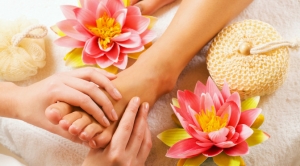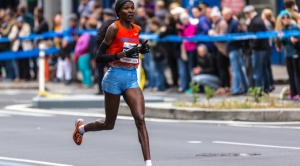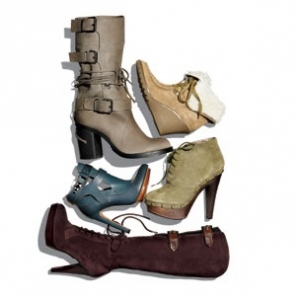Connect With Us
Blogs
Displaying items by tag: Foot Doctor
The Health Benefits of Regular Foot Massages
There are many physical and psychological health benefits related to foot massages. Daily foot massages, for a couple minutes at a time, has been proven to fight depression and relieve headaches. Here is a list of the many health benefits of having regular foot massages.
Stress Relief
Regular foot massages have been shown to greatly relieve stress, as well as, many of the symptoms associated with it, such as energy loss and headache. A five to ten-minute foot massage, after a long day, can significantly relieve fatigue and increase feelings of well-being. Try using scented oil when administering your foot massage, for the added benefit of aromatherapy.
Blood Circulation & Sleep
Poor blood circulation causes many foot health issues. Regular foot massages can regulate your blood flow and keep your feet healthy, as well as, combat foot health problems such as inflammation, swelling, and pain. Foot massages also stimulate the limbic system and help prevent varicose veins. When night falls, massaging your feet right before bed helps you unwind, relax your nerves, and relieve any aches and pains-promoting restful sleep. Try using a lavender scented oil when administering your foot massage, as the lavender scent in calming and promotes relaxation.
Foot Health
Not only does regular foot massage promote healthy blood circulation, it can also relieve everything from minor aches to arthritis pain. In addition, it has been shown that regular foot massages, with olive or coconut oil, can significantly relieve the pain associated with foot tendonitis. Additionally, daily foot massage can help strengthen your ankles and increase your flexibility, which can prevent foot-related injuries.
Pain & Depression
While it’s well known that foot massages relieve foot pain, it also an effective way to treat other common body aches and pains. For example, regularly massaging your ankle and Achilles tendon can help relieve lower back pain and pressure. Additionally, because foot massage is such an effective stress relief treatment, it has also been shown to relieve migraine and headache pain. Regular foot massages also help you feel relaxed and balanced, promoting a sense of calm. Considering stress, tension and fatigue are associated with situational depression, daily foot massages have been shown to not only combat to these symptoms, but depression itself.
Other Health Benefits
- Helps manage PMS and Menopause symptoms.
- Assists those suffering from restless leg syndrome manage their illness.
- Relieves swollen feet during pregnancy.
- Relieves the chronic pains of arthritis in the feet and legs.
- Helps those with minor foot injuries to heal quicker.
Now that you are aware of the health benefits from regular foot massages, be sure to incorporate this into your daily routine, along with your regular visits to Superior Foot & Ankle Care Center. If you have any questions or concerns about your foot health, please feel free contact us today, at 562-420-9800.
Foot Health Tips for Athletes
Athletes are busy people. Whether they’re students balancing homework and extracurricular activities, or 9-5 workers trying to stay in shape in the evenings, athletes only have limited time for everything else. Focus on diet, exercise, and responsibilities, foot health is one of the last things on an athlete’s list of concerns. If you or someone in your family leads an active lifestyle, make sure they’re taking the time to take heed of the following foot care tips.
Shoes
If you’re devoted to a particular sport, you probably have a great pair of sport-specific shoes already. If for some reason you don’t, or you’re planning to start playing a new sport regularly, make sure that you get a specialized pair, soon. Basketball shoes, for example, have a very particular type of cushioning designed for rapid changes in direction and hard landings. If your shoes don’t fit well or aren’t designed for the activity, you could be risking injury.
When looking for shoes, shop in the afternoon or later, when your feet swell to their largest size. And one more thing: shoes tend to lose shock absorption between 250-500 miles. Runners who go for 25 miles every week will need new shoes, every 2.5-5 months.
Socks
Any old pair of socks might seem to do the trick, but believe it or not, those fancy Nike or Underarmor logo socks really do have a purpose. If your socks aren’t made with moisture-wicking fabric, the fabric will retain moisture for too long and may cause blisters.
College students, stay on top of your laundry: if you don’t change your socks often, you could develop foot odor.
Blisters, and Calluses
Speaking of blisters, don’t ever pop them. If they happen to pop, wash the area, apply antiseptic, then apply a bandage.
As for calluses, talk to your doctor before making a decision. Don’t try to remove them on your own, even if you have an over-the-counter product.
Toenails
Make sure toenails are trimmed to avoid in-grown nails. Cut the nails straight across, but leave them slightly longer at the end of each toe. Watch out if they turn black or blue; it could be a sign of blood underneath the nail, or possibly a condition like melanoma or an infection.
That should cover most (if not all) potential foot problems. If you take nothing else from this article, remember to practice proper hygiene, and use proper sports shoes and socks.
Feel free to contact us you have any further questions and concerns about your foot health. For a consultation, call Superior Foot & Ankle Care Center, at 562-420-9800, to set up an appointment today.
How to Prevent Running Injuries
Overtraining and overusing the feet are the main causes of common running injuries. A number of these common injuries are caused by overrunning. Runner’s knee is a condition that is characterized by the back of the kneecap beginning to wear away and cause pain in the knee. This frequently occurs due to either a decrease in strength in the quadriceps muscles or ill-fitting shoes that are lacking in proper support for the inside of the forefoot. Strengthening exercises focusing on the quad muscle and sports orthotics are the usual treatments for those suffering from runner’s knee. Prevention of the condition lies in a focus on hip strengthening and quad-strengthening to keep the kneecap aligned. To help learn the best exercise to heal runner’s knee, one can also undergo physical therapy.
One common injury, called iliotibial band syndrome, is often caused by overtraining. This condition occurs when the iliotibial band gets irritated, creating pain and discomfort in the outside knee area. Plantar fasciitis, another common running injury, also occurs as a result of inflammation and irritation. Plantar fasciitis is an inflammation and irritation of the bone in the foot. A large amount of pain is often experienced due to plantar fasciitis. The condition can be caused by a high arch, improper footwear, tight muscles, or flat feet. It can best be avoided by stretching and wearing appropriate footwear that supports the foot.
Another common injury for runners is stress fractures. These injuries occur due to running style, overtraining, or a lack of calcium. Stress fractures most often occur in several locations in runners, including the inner bone of the leg, the thighbone, the bone at the base of the spine and the bones of the toes. Stress fractures are best prevented by wearing proper footwear and by running on flat and hard surfaces; this will absorb some of the shock created during running.
Aside from overtraining, other causes of common running injuries include ill-fitting footwear, a lack of flexibility and strength, and irregular biomechanics. The best way to avoid running injuries is to prevent them from even occurring. Both iliotibial band syndrome and stress fractures are preventable. The first step that should be taken to prevent running injuries is to only wear footwear that fits properly and that is appropriate for whatever activity you are doing. Running shoes are the only protective gear available to runners that can safeguard them from sustaining injuries. Choosing the right pair of shoes is therefore extremely important. While running shoes are an important factor, it is also important to consider other facets of your running routine such as training schedules, flexibility, and strengthening. These elements should be considered and altered according to your running needs to best maximize your run and minimize the possibility of injury. Careful stretching before and after a run should also be considered to help prevent running injuries. Stretching muscles enables greater flexibility and a lesser chance of sustaining injury.
Why do Bunions Hurt During Colder Weather
Many people who suffer from bunions tell their podiatrist that cold weather makes their bunion hurt worst. There is no evidence that cold weather is what is causing the increase in pain. Rather, foot doctors believe that it is the change in the type of foot wear people use during cold weather that causes the increase in pain.
Most patients seeking bunion treatment are women. During fall and winter, women stop wearing sandals and open-toed shoe styles and start wearing boots and closed-toed shoes. This big change in their footwear can cause irritation to the bunion.
Foot doctor Long Beach recognizes that there is an increase in bunion treatment during cold weather because patients wear shoes that aggravate the joint bursa. Once the joint bursa is aggravated, it becomes red and inflamed, causing the bunion to ache.
Bunions do not go away over time or on their own. Once a bunion forms, it is best to seek bunion treatment from a foot doctor Long Beach. People with bunions will have periods where the bunion does not hurt but over time, the bunion can become irritated and grow. Bunion treatment can be conservative and painless but it is up to the patient to seek treatment. Bunion surgery Long Beach is usually the final answer in safe, permanent bunion treatment.
Women love shoes and during the colder seasons, they seek out stylish boots. Unfortunately, those boots can cause more traumas to the feet. Bunions form on the big toe joint which can be pushed on by tight, ill-fitting, or leather boots. The problems and pain are increased when the boots have a heel. The pain during fall and winter can make some women wish they didn’t have to wear shoes at all.
The pain patients feel from winter style shoes does not just cause more pain now but it can cause bigger bunions over time. Harvard Health Publications urges women to wear the right kind of shoes. If you have a bunion, be mindful of wearing wide shoes with a flexible sole. Heels and boots will not accommodate the bunion and can make mattes much worse.
The bunion surgeon Long Beach patients trust most can discuss your bunion treatment options to begin your road to a bunion pain-free life.



